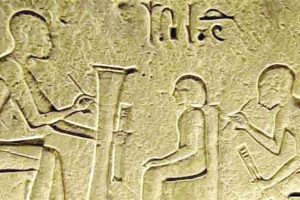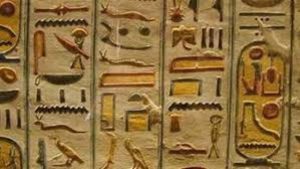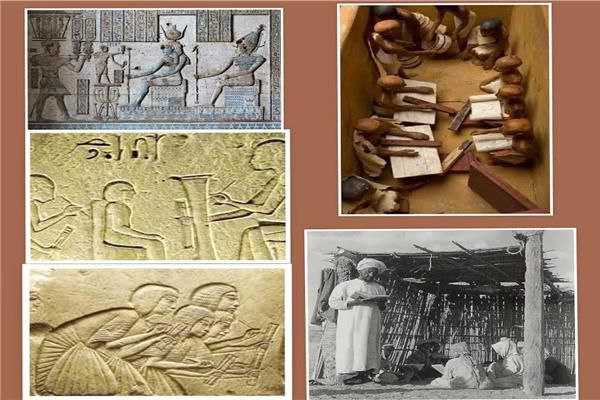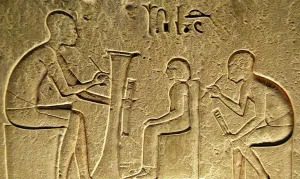By Hossam Zidan
Researcher Nagat Essam, specializing in the history of ancient Egypt, has uncovered details about the educational system of the ancient Egyptians, the first to establish schools and promote literacy. They also practiced homeschooling. The age of admission for children to schools was ten, initially limited to the sons of kings, nobles, and elites. Over time, the ancient Egyptian civilization expanded the establishment of schools and specialized educational institutions. The Egyptians introduced vocational education, teaching trade and administration, and established military schools for training in combat and military sciences, as well as religious schools attached to temples.
Formal schools in Egypt date back to the Middle Kingdom, where the first schoolbooks appeared. These schools were initially housed in the royal palace. Archaeological discoveries confirm the existence of schools throughout ancient Egypt, such as the Ramesseum school, one in Deir el-Medina in Thebes (modern Luxor), another in Akhenaten’s city at Tell el-Amarna, and schools in Abydos (Sohag), On (Heliopolis), and Tel Basta, among others.

The ancient Egyptians referred to schools in hieroglyphs as “Per Ankh,” meaning “House of Life,” and sometimes as “Iat Seba,” meaning “Place of Learning.” Teachers were called “Sebaw,” meaning “star” or “guide.”
Each school had libraries, known as “Per Seshu,” meaning “House of Scrolls,” containing papyri on various subjects, serving as textbooks and references for students. The goddess Seshat was the patron deity of these libraries. Education was mostly conducted outdoors in open courtyards rather than in closed classrooms, a system that some modern countries strive to emulate. Students would sit on the ground around their teacher.
The First Stage
Education in ancient Egypt was divided into several stages, starting with primary school, where students learned the basics of religion, the alphabet, and arithmetic. Teaching methods in this stage involved encouraging learning through simple explanations, sometimes accompanied by punishment. Students at this level were not allowed to use papyrus for writing but practiced on pottery and limestone. After completing this stage, students were employed as scribes in government offices, progressing to the second stage of education.

The Second Stage
In the second stage, scribes continued their education under the guidance of senior scribes. This phase became increasingly complex, focusing on advanced writing skills and arithmetic, and can be considered a vocational training stage that prepared scribes for administrative work in government offices.
The Third Stage
Dr. Saeed Ismail, in his book *Ancient Egyptian Civilization*, describes the third stage as equivalent to today’s postgraduate studies. In this stage, students pursued more specialized knowledge in medicine, mathematics, astronomy, and the arts. These schools were attached to palaces and temples and gathered the most educated and cultured scribes. Books on various sciences, including theology, medicine, and engineering, were written here.
Dr. Ismail outlined the ancient Egyptian curriculum, which consisted of six main subjects. Language, including reading and writing, was treated with great reverence, as it was believed to be one of the divine secrets. Egyptian writing evolved into a phonetic language, using a complex system of signs arranged to convey meaning.
Literature was closely connected to writing, with proper linguistic expression and rhetoric being emphasized. According to Dr. Selim Hassan’s book *Ancient Egyptian Literature*, ancient Egyptian literature ranged from prose letters to poetry, much of which focused on religious and moral themes, such as the *Papyrus of Ani* and its depiction of the afterlife. Some works also highlighted the struggles of Egyptians, such as *The Eloquent Peasant*.
The Curriculum in Ancient Egypt
Egyptologist Dr. Abdel Rahim notes that the curriculum in ancient Egypt included various arts and sciences, such as medicine and pharmacy. Egyptian knowledge of anatomy was advanced due to their mastery of mummification, which led to their expertise in diagnosing and treating diseases, either through medicines or surgery, as documented in medical papyri and temple wall scenes that illustrate their medical prowess.
Astronomy and Arts
The ancient Egyptians were pioneers in astronomy and the development of the calendar, using these skills to determine agricultural cycles. They also excelled in the arts, particularly in painting, sculpture, engraving, architecture, music, and singing. Their paintings and carvings often depicted religious themes, illustrating relationships with the gods and the journey to the afterlife. Some carvings also portrayed daily life in ancient Egypt.
Mathematics
The Egyptians were familiar with numbers from the earliest historical periods. Mathematics flourished during the 12th Dynasty, as evidenced by papyri containing detailed explanations of land measurements, division, multiplication, and mathematical roots. This knowledge enabled them to calculate land areas and impose appropriate taxes. Dr. Ismail considers the construction of the pyramids to be proof of the Egyptians’ superiority in mathematics and engineering.









































admin in: How the Muslim Brotherhood betrayed Saudi Arabia?
Great article with insight ...
https://www.viagrapascherfr.com/achat-sildenafil-pfizer-tarif/ in: Cross-region cooperation between anti-terrorism agencies needed
Hello there, just became aware of your blog through Google, and found ...